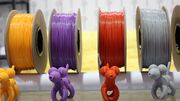3D printing filaments
Jump to navigation
Jump to search
Description
Thermoplastic feedstock used by fused deposition 3D printers to create a product.
Synonyms and Related Terms
Comparison Table
| Filament Type | Pros | Cons | Common Applications |
|---|---|---|---|
| PLA (Polylactic Acid) | Easy to print, low temperature, good surface finish, low odor, biodegradable | Brittle, low heat resistance, can warp | Prototyping, decorative objects, toys |
| ABS (Acrylonitrile Butadiene Styrene) | Strong, durable, high temperature resistance, good for functional parts | Prone to warping, requires heated bed, strong odor | Functional parts, mechanical parts, enclosures |
| PETG (Polyethylene Terephthalate Glycol) | Easy to print, low odor, good strength and durability, food-safe (select grades) | Can be scratched easily, can absorb moisture | Food containers (select grades), bottles, mechanical parts |
| Nylon | Very strong and durable, flexible, abrasion resistant, high temp resistance | Absorbs moisture (requires drying), can be difficult to print | Functional parts, gears, bearings, tools |
| TPU (Thermoplastic Polyurethane) | Flexible, elastic, impact resistant, good for flexible parts | Can be difficult to print, requires specific settings | Flexible parts, phone cases, gaskets, seals |
| PC (Polycarbonate) | Extremely strong and durable, high temperature resistance, impact resistant | Difficult to print, requires high temperature, prone to warping | Functional parts, engineering prototypes, high-strength applications |
| ASA (Acrylonitrile Styrene Acrylate) | UV resistant, weather resistant, strong, durable, good for outdoor use | Similar to ABS in printing difficulty, can have strong odor | Outdoor parts, automotive parts, weather-resistant applications |
| PEEK (Polyetheretherketone) | Extremely high temperature resistance, chemically resistant, very strong | Very expensive, very difficult to print, requires very high temperatures | High-performance applications, aerospace, medical implants |
| Carbon Fiber Filled | Increased strength and stiffness, lightweight, improved dimensional stability | Can be abrasive (wear on nozzles), more expensive | Structural parts, drones, robotics |
| Wood Filled | Unique aesthetic, can be sanded and stained, gives a wood-like appearance | Can be brittle, more difficult to print than PLA, can absorb moisture | Decorative objects, models, art projects |
| Metal filled | Realistic metal feel and weight, can be post-processed (e.g., polishing) | Can be abrasive, more difficult to print, more expensive | Decorative objects, models, tools |
Risks
Working Properties
Forms and Sizes
- Common types are 1.75mm and 2.85mm
